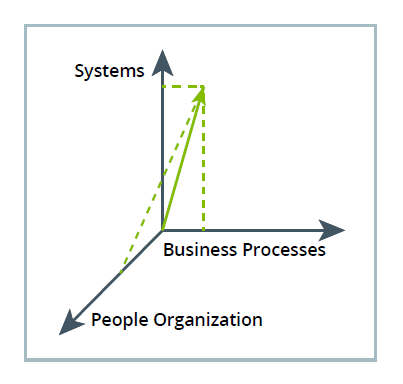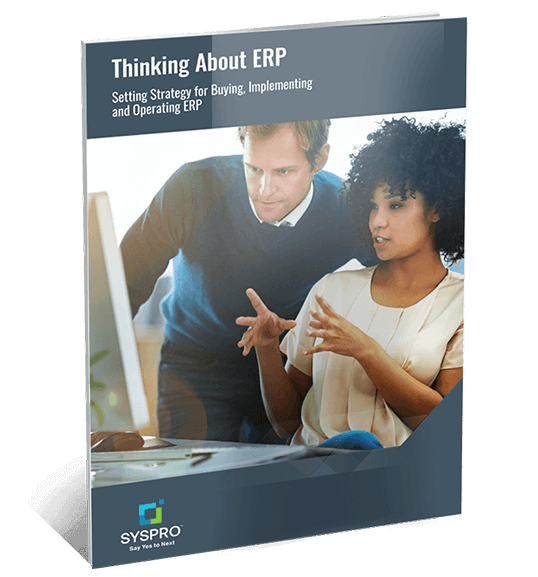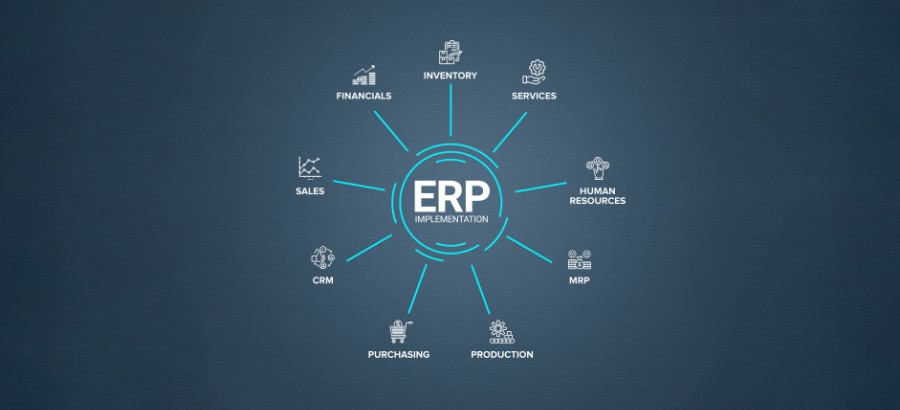Part of the process of selecting an ERP system is to appreciate how the software is going to be used. In Part 2, I discussed the ‘Dimensions of Change Model’, a method of how to think about the process, system and structural changes that an organization will go as a result of an ERP implementation. In Part 3, the process and steps for selecting an ERP were covered – the role players, and the issues of best practice and customization. The Dimensions of Change model also comes into the selection process – that is what will be addressed now.
To recap, in the Dimensions of Change [Executive Guide Part 2] we use the term ‘degrees of freedom’ to define the dimensions in which a system can move. For an enterprise, those dimensions are the IT systems, the business processes, and the organizational structure. An ERP implementation will involve a system change at least (the ERP solution), and may also include one or both of the other dimensions.
 |
The following strategies each need to be considered when evaluating and selecting an ERP system, with variations depending on which level of change your ERP project will encompass.
|
For a One Degree of Freedom ERP selection
This type of project is about the ERP solution rather than business processes or organizational issues. The aim is to get benefits from a better system, not from better ways of working or organizing.
- Decision-making authority: Since this is primarily a technical project, someone with IT knowledge should lead the selection process. This may be the IT manager but outside assistance may be needed if ERP expertise is required.
- User participation: Just because this is an IT-oriented project does not mean it is also IT-only. To get a solution that delivers benefits to the whole enterprise, the selection team should include staff from various functions, not just technical people. The non-technical staff are there to ensure the ERP solution supports current business processes.
- Business process requirements: In this type of project the aim is to minimize any changes to existing business processes.
- Policies and guidelines: The key criteria for the selection team is for an ERP system that will fit current business processes. There may also be other criteria such as cost, availability of support, and amount of training needed.
- Structured selection process: The main benefits in this project come from the new ERP system. Any major customizations, or requirement for external applications, will have a significant negative impact on the selection of a system.
A Two Degree of Freedom (Business Process) ERP selection
The reason for this type of project is to change the way the organization works, i.e., the business processes. Achieving this requires a new system.
It is recommended to first design the business processes at a high level, then select an ERP system that enables those new processes. Doing the selection process this way means the important parameters, the business processes, are defined first and thereafter the ERP application must fit in.
- Decision-making authority: This is not a technical project but rather one of discontinuous change with the ERP system enabling that change. It is common practice for functional heads to sign off on the design of new high-level business processes. The executive decision-maker should play a major role. However, in most cases, this role requires more time (and probably expertise) than the executive can afford so a project manager is brought in to represent the executive.
- User participation: Obviously with this type of project, functional representatives are involved in the selection as well as IT staff. In the business process design phase, the non-technical staff determine and lead the project, perhaps guided by an external consultant. When it comes to the ERP system, then IT people can take over, with the functional personnel ensuring that the new system can support the new processes.
- Business process requirements: When redesigning business processes, both As-Is (existing) and To-Be (new) processes need to be mapped. The reason for this is to set a starting position (As-Is processes), with the To-Be processes as the goal.
- Policies and guidelines: It should be stated that enabling the new businesses processes is key, and that they will not be modified to suit an ERP system. An ERP system must verify that it can support these processes, and very little change to organizational roles will be allowed.
- Structured selection process: There are several stages to this.
- Scope the processes that will be changed.
- Identify functional process owners and give them training on processes and what is best practice.
- Evaluate whether the scoped business processes need re-design.
- Design new processes and then have the project team, and other parts of the organization, assess and decide whether to accept them or not.
- Using the short list of potential ERP providers, evaluate how the ERP solutions match the new business processes, and how much modification is needed for the software to support the processes. This stage requires in-depth and thoughtful work, and oversight by senior executives is advisable.
A Two Degree of Freedom (People-Organization) ERP selection
Organizational re-structuring is the justification for this project. An ERP system is seen as the way to rationalize functions and automate tasks. Even though business process change is not intended in this project, some significant changes will be needed.
- Decision-making authority: Because this project directly affects people, it is a sensitive undertaking. Whether work is done completely in-house, or with the help of external consultants, it needs to be driven by senior executives to ensure concerns are managed.
- User participation: There is usually not much choice for the people involved in the change, but change is usually on a limited selection of an organization’s structures. Nevertheless, staff buy-in is important for this type of project to succeed.
- Business process requirements: The process of changing organizational functions will inevitably mean some business process changes. Accompanying the structural changes, To-Be business processes will need to be defined.
- Policies and guidelines: Because the project focus is on structural changes rather than process changes, policies to limit scope creep are important.
- Structured selection process: As in the previous case, there are multiple steps.
- Identify the organizational aspects to change.
- Design the new organization structure, and associated processes,
- Get the changes reviewed and approved.
- The evaluation of the ERP vendor short list should be based factors such as on task automation, quality of user interface and experience, culture-fit and capability.
A Three Degrees of Freedom ERP selection
This project is rare, and potentially high risk. But it can occur when new divisions are created, or after major acquisitions and mergers.
- Decision-making authority: This project has to be led from the top and therefore should have a board-level executive full-time on the project.
- User participation: No person, function or process is exempt from change in this type of project. Communication and involvement are imperative to reduce sensitivities and ensure buy-in from staff.
- Business process requirements: The business processes developed form the blueprint for the organization, in the same way as an architect’s plan show how a house is to be built.
- Policies and guidelines: In a project like this, there will be few policy constraints and the team usually has freedom to consider many options. The major constraint is time, as the organization has to go ‘on hold’ and cannot be like that for too long. The team also has to ensure their decisions do not go against the strategies that direct this project.
- Structured selection process: In this case, the design elements (people, function, process) have to be established first. Then the selection process can begin. The evaluation of solutions can be more extensive as the issue of future-fit will be important, bearing in mind that there is also a risk because the new designs are unproven.
Moving to the next stage
While each type of selection project follows five strategies, the way they are executed, the amount of work and who does it is completely different. That is why it is important to understand the ‘Degrees of Change’ model. However, if it properly applied, then at the end of the selection process the organization has an ERP system, business process blueprint and, possibly, new organizational design with which it can move forward. The next stage is how to make the change happen – the implementation project.
 |
Download our Thinking About ERP eBook to learn more.Setting strategy for buying, implementing and operating ERP. This eBook shows executives how to drive ERP implementation from the top and focus on key performance measures. Through clearly defining what the ERP project is meant to achieve, organizations can pursue their strategic objectives. If you do nothing else before starting your ERP project, read this book – it will make all the difference. |








2 thoughts on “Executive Guide to ERP Part 4”
Best Private University in Delhi NCR
When it comes to higher education in India, particularly in the National Capital Region (NCR), private universities have emerged as leading institutions offering innovative programs and a robust learning environment. Among these, one university stands out due to its exceptional infrastructure, committed faculty, and a curriculum that aligns with industry standards: [University Name]. This university has established itself as a top choice for students seeking a comprehensive and modern education.
State-of-the-Art Infrastructure
One of the defining features of [University Name] is its state-of-the-art infrastructure. The campus is designed to provide a conducive learning environment, equipped with modern classrooms that utilize the latest technology to enhance the educational experience. Each classroom is fitted with audio-visual aids, smart boards, and high-speed internet access, ensuring that students engage in interactive learning.
The university also boasts well-equipped laboratories for various disciplines, including engineering, sciences, and arts. These labs are designed to facilitate hands-on learning, allowing students to experiment, innovate, and apply theoretical knowledge to real-world scenarios. In addition, the campus features advanced computer labs with the latest software, ensuring that students are adept in the technologies relevant to their fields.
Extensive Library Facilities
A robust library is a cornerstone of any educational institution, and [University Name] offers an extensive library that caters to the diverse needs of its students. The library houses a vast collection of books, journals, and research papers across various disciplines. Students have access to digital resources, including e-books and online journals, ensuring they can stay updated with the latest research and trends in their fields.
The library is not just a repository of knowledge; it is also a space for collaborative learning. With dedicated study areas and group discussion rooms, students can engage in discussions, share ideas, and collaborate on projects. The library also hosts workshops and seminars, enhancing students’ research skills and academic development.
Experienced Faculty Members
At [University Name], education is driven by a team of experienced faculty members who bring a wealth of knowledge and practical insights to the classroom. The faculty comprises industry professionals, researchers, and scholars who are passionate about teaching and mentoring students. Their diverse backgrounds enrich the learning experience, providing students with various perspectives and expertise.
The faculty is committed to fostering an interactive learning environment, encouraging students to ask questions, participate in discussions, and engage in critical thinking. Regular feedback sessions help students understand their strengths and areas for improvement, further enhancing their academic journey.
Industry-Relevant Curriculum
A key strength of [University Name] is its emphasis on an industry-relevant curriculum. The university regularly reviews and updates its programs to ensure they align with current industry standards and trends. This approach prepares students to meet the challenges of the professional world head-on.
The curriculum includes practical training, internships, and projects that allow students to apply their knowledge in real-world situations. Collaboration with various industries ensures that students gain insights into the latest practices and technologies used in their fields. Moreover, guest lectures and workshops by industry experts provide valuable networking opportunities and real-world insights.
Student-Centric Approach
[University Name] takes pride in its student-centric approach, focusing on the holistic development of students. The university offers a range of extracurricular activities, clubs, and organizations that encourage students to explore their interests beyond academics. From cultural festivals to sports events, students have numerous opportunities to showcase their talents and develop leadership skills.
The university also provides career counseling and placement services to assist students in their transition from academics to the workforce. Regular workshops on resume building, interview preparation, and soft skills development equip students with the tools they need to succeed in their careers.
Conclusion
In conclusion, [University Name] stands out as one of the best private universities in Delhi NCR, distinguished by its modern infrastructure, experienced faculty, and industry-relevant curriculum. The university is dedicated to providing a comprehensive educational experience that prepares students for the challenges of the professional world. With its emphasis on practical learning, student engagement, and holistic development, [University Name] is an ideal choice for aspiring students seeking quality education in a dynamic and supportive environment.
As the demand for skilled professionals continues to rise, institutions like [University Name] are leading the way in shaping the future of higher education in India. Whether you are looking to pursue a career in engineering, business, arts, or any other field, [University Name] offers the resources, support, and opportunities needed to help you achieve your goals and excel in your chosen path.
Discovering the Best E-Rickshaw Manufacturer: Dabang EV
In recent years, the way we think about transportation has changed a lot. With growing concerns about pollution and the environment, electric vehicles (EVs) are becoming more popular. One of the standout options in this new world of green transportation is the E-rickshaw. These small electric vehicles are perfect for navigating busy streets, and Dabang EV is one of the top manufacturers making them.
What Are E-Rickshaws?
E-rickshaws are electric three-wheeled vehicles used primarily for transporting passengers and goods. They have become a common sight in many cities, especially in India, where they offer a cost-effective and eco-friendly alternative to traditional auto-rickshaws. These vehicles run on electric batteries, which means they produce zero emissions, making them a cleaner choice for urban transport.
Why Choose Dabang EV?
When looking for the best E-rickshaw manufacturer, Dabang EV stands out for several reasons:
Diverse Range of Models: Dabang EV offers various E-rickshaw models to cater to different needs. Whether you want to transport passengers or carry goods, they have a vehicle that suits your requirements. Their lineup includes comfortable passenger carriers and sturdy goods transporters.
Advanced Technology: Dabang EV’s E-rickshaws are equipped with modern electric drivetrains. This technology ensures smooth operation, better performance, and longer battery life. The efficient energy use means you can travel farther on a single charge, making these vehicles ideal for daily use.
High-Quality Materials: Quality is key when it comes to vehicles. Dabang EV uses durable materials to build their E-rickshaws, ensuring they can withstand the rigors of daily transportation. This focus on quality translates to lower maintenance costs and longer vehicle life.
Benefits of E-Rickshaws
E-rickshaws come with numerous benefits that make them an attractive choice for many:
Environmentally Friendly: Since they run on electricity, E-rickshaws do not emit harmful gases like traditional fuel-powered vehicles. This helps reduce air pollution and contributes to a cleaner environment.
Cost-Effective: Operating an E-rickshaw is generally cheaper than a conventional auto-rickshaw. The cost of electricity is often lower than fuel prices, which can lead to significant savings over time.
Maneuverability: E-rickshaws are compact and designed for urban environments. They can navigate through tight spaces and heavy traffic, making them ideal for cities.
Low Noise Pollution: Electric vehicles operate quietly compared to gas-powered vehicles. This means less noise pollution in busy urban areas, creating a more pleasant environment for everyone.
Safety Features
Safety is crucial in any vehicle, and Dabang EV prioritizes it in their E-rickshaws:
Robust Design: The sturdy frame of Dabang EV’s E-rickshaws ensures stability and safety for both drivers and passengers.
Advanced Braking Systems: These E-rickshaws come with reliable braking systems that provide excellent stopping power, essential for navigating crowded streets.
Visibility: Good lighting systems help drivers see clearly at night and make the vehicle more visible to others on the road.
Customer-Centric Approach
Dabang EV believes in putting the customer first. Here are a few ways they ensure satisfaction:
Customization Options: Understanding that different customers have unique needs, Dabang EV offers customizable features. This means you can select options that fit your specific requirements.
After-Sales Service: Dabang EV provides excellent after-sales support. If you have questions or need maintenance, their team is ready to help. This commitment to service builds trust and ensures a positive experience for customers.
Affordable Pricing: Dabang EV aims to make electric mobility accessible to everyone. Their competitive pricing and financing options help more people consider switching to E-rickshaws.
The Eco-Friendly Impact
By promoting the use of E-rickshaws, Dabang EV is making a significant contribution to sustainability. As urban areas grow, the need for cleaner transportation options becomes even more pressing. E-rickshaws play a crucial role in reducing emissions and improving air quality.
Moreover, using E-rickshaws helps create quieter cities, enhancing the quality of life for residents. With less noise and pollution, urban environments can become more livable and enjoyable.
Market Presence and Growth
Dabang EV has established itself as a leader in the E-rickshaw market. Their commitment to quality and innovation has earned them a solid reputation. Their vehicles are widely used in many cities, and they continue to expand their reach.
As electric mobility gains traction globally, Dabang EV is well-positioned to tap into international markets. This growth mindset not only benefits the company but also contributes to the larger goal of promoting sustainable transportation worldwide.
Conclusion
In a time when sustainability is crucial, Dabang EV shines as a top E-rickshaw manufacturer. Their commitment to producing high-quality, efficient, and eco-friendly vehicles makes them a standout choice for anyone looking to invest in electric mobility.
With a diverse range of models, advanced technology, strong safety features, and a customer-first approach, Dabang EV is paving the way for a cleaner, greener future. If you’re considering an E-rickshaw for personal use or a business venture, Dabang EV is undoubtedly a reliable and forward-thinking option. Transitioning to electric mobility not only makes economic sense but also contributes to a healthier planet for future generations.